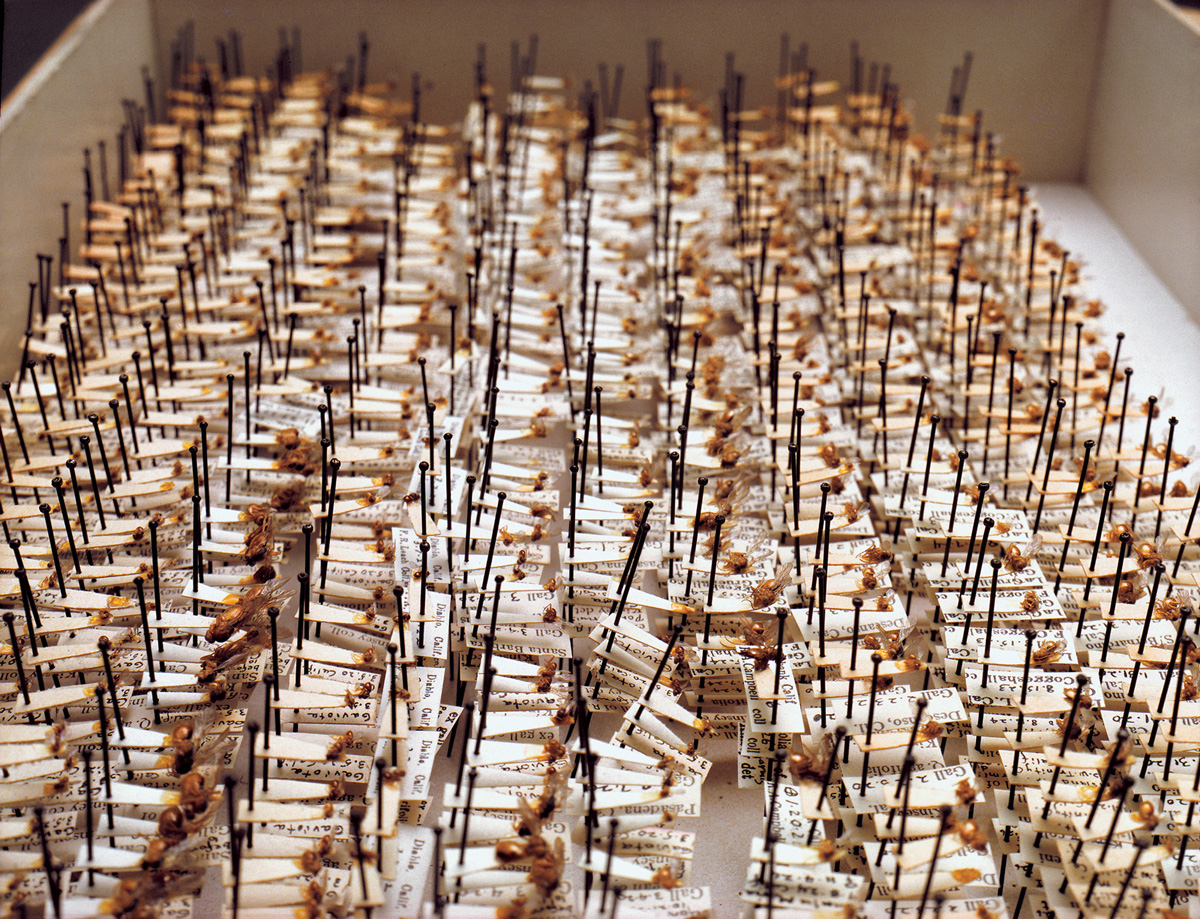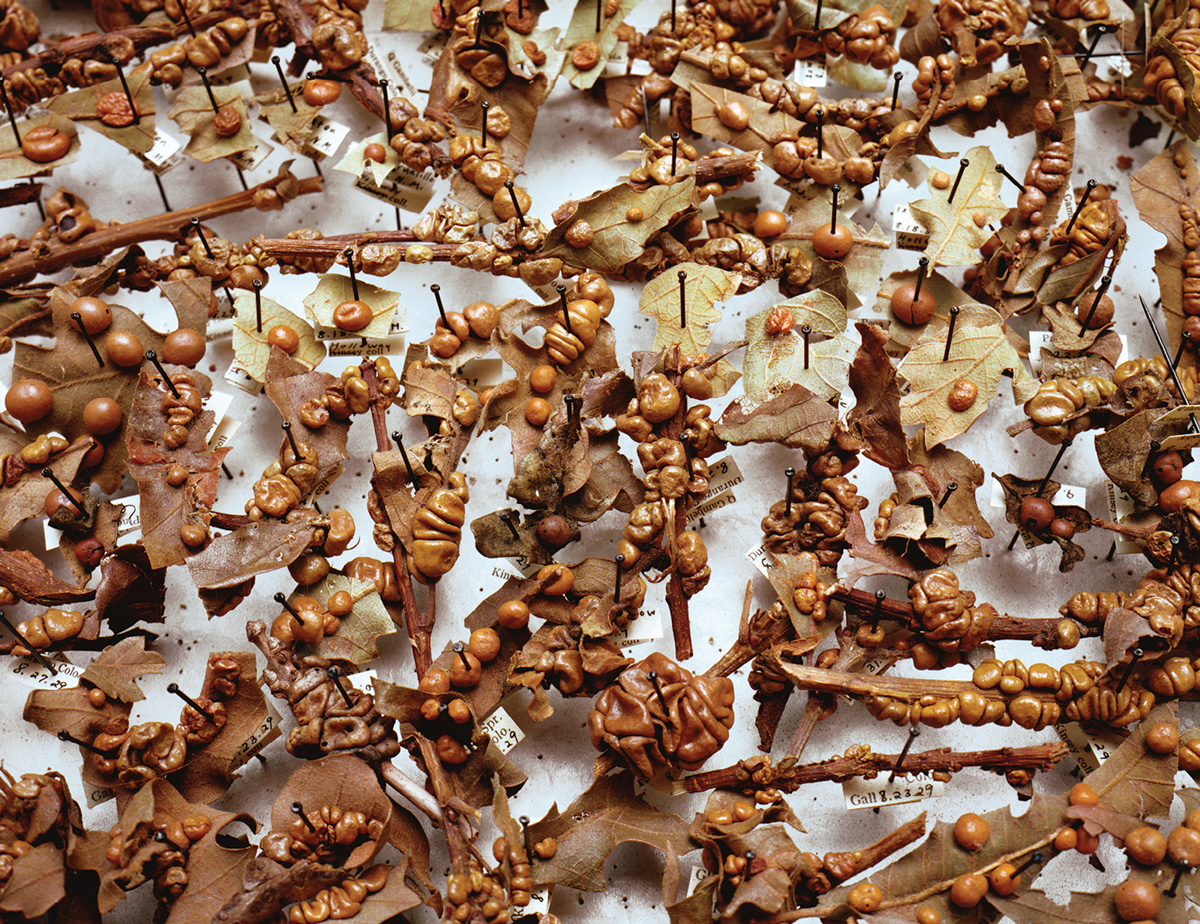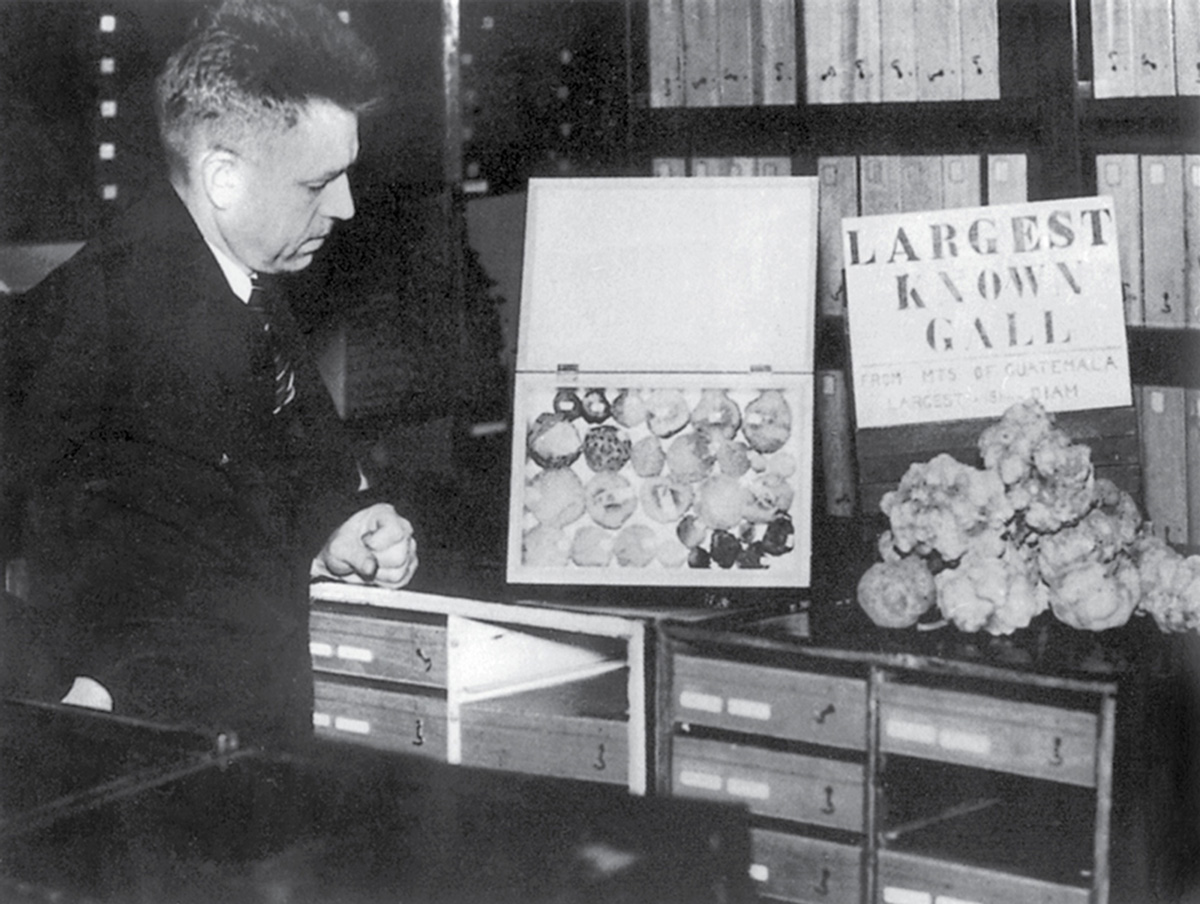A Lot of Gall
Dr. Kinsey’s wasps
Christopher Turner

James M. Carpenter, curator of entomology at the American Museum of Natural History in New York, leads me to a sixty-foot-long room in the bowels of the museum. The walls are lined with fifty-four sizeable metal cabinets. Carpenter unlocks the first of these, which is piled precariously with Schmitt boxes, each chalked with a number. He carefully wedges one out and opens it. Inside are about eight hundred tiny insects which swarm in impressively neat formation, all facing right on their pins, riding above two miniscule labels filled out in a meticulous and miniature hand. This is the gall wasp collection of Alfred C. Kinsey.
Before he became a celebrated sex researcher, Kinsey was a zoologist who studied and collected these wasps, each one a brown smudge roughly the size of a fruit fly. When he died, he bequeathed an astounding 7.5 million specimens to the Museum of Natural History, where he had received his first entomological instruction as a young boy on a visit from South Orange, New Jersey. The collection was valued at $250,000 in 1958, two years after Kinsey’s death, and it makes up a huge portion of the museum’s eighteen million insect- and spider-related artifacts. “There was hardly anything like it before,” Carpenter marvels, as we gaze at an infinity of bugs (the original accession record boasted that it was “the finest collection of its kind in the world”), “and there hasn’t really been a collection like it since.”
Though many of the gall wasps have been rehoused by volunteers using contemporary archival methods, the collection has remained almost unused since Kinsey’s death, of interest more to his biographers than to entomologists. Even in the 1930s, when Kinsey published most of his work on gall wasps, population genetics was supplanting taxonomy as the primary field of study. However, only the week prior, Carpenter tells me, scientists succeeded in extracting DNA from one of Kinsey’s eighty-year-old wasps, “so this collection does become more valuable all of a sudden.” Historians of sex, on the other hand, are interested in how Kinsey’s exhaustive sample, taken from all over North America, and the rigorous taxonomic techniques he used to classify them, with their emphasis on individual variation, foreshadowed the methods he used to document the nation’s sexual history. “Men,” Kinsey once said dispassionately, “are just bigger, more complicated gall wasps.”
Gall wasps are winged but mainly flightless members of the genus Cynips and lay their eggs in oaks and sometimes roses. The female deposits a poison with her eggs that irritates the tree so that it sprouts an excrescence—commonly known as an “oak apple”—to house the larvae that hatch there. These galls, which grow from branches like thyroid goiters, can take a variety of forms and serve, Kinsey wrote, as “a dining room and a bed-chamber for the creature during its larval life.” Some are the size of currants, while others are as big as coconuts. (Gall wasps, it turns out, are the unnoticed heroes of civilization, the tannic acid contained in their galls having been an essential ingredient of ink for centuries. Leonardo, Dürer, Bach, Rembrandt, and Van Gogh all wrote and drew in iron gall ink). After anything from a few months up to four years, the tiny pupae chew their way out of these structures, and the cycle begins again.

Unlike social wasps, which are Carpenter’s area of expertise, gall wasps are solitary creatures, lacking castes, queens, workers, and a sting. (“I try to collect entire colonies,” Carpenter tells me of his own research, as he models a beekeepers’ hat, “so I get stung all the time. There are certain kinds of social wasp that will land on your veil and then spray venom into your eyes—so I’ve got to wear goggles when I’m dealing with the genus Parachartergus.”) As well as being gall-producing, Kinsey’s antisocial wasps have an additional peculiar characteristic: they produce alternating generations—one of which is able to reproduce without sex—that, as Kinsey described them, “bear no more resemblance to their parents, for instance, than a sheep bears to a goat, or a squirrel to a groundhog.”
Kinsey started collecting gall wasps in 1917 when he began his Ph.D. devoted to them at Harvard under W. H. Wheeler, who himself collected over a million ants (a colony now housed at the Museum of Comparative Zoology in Harvard). Kinsey, who was determined to outdo his mentor, was soon known by his peers as “Get a million Kinsey.” After he received his doctorate in 1919, he was awarded a traveling scholarship that enabled him to spend a further fifteen months in the field, which would help him surpass that total. Kinsey traveled eighteen thousand miles, twenty-five hundred on foot, and visited thirty-six states. He hiked to the most inaccessible places, “inasmuch as oaks in which gall wasps occur especially are found only on the highest mountains.” In one remote part of Arizona, he emulated his subject by not seeing a member of his own species for a week, and when he stayed the night in an abandoned hut on a hillside in Montana, he was snowed in for two days. In all, three hundred thousand galls were sent back to Harvard, the larvae in some of which hatched prematurely, infesting the biology labs.
Kinsey continued his research at Bloomington, Indiana, where he would spend the rest of his academic life and which still encompasses the Kinsey Institute of Sex Research. Back in his lab, Kinsey—and the students who were happy to be paid thirty cents an hour to help him—would lift each insect with tweezers and dip it in the killing jar before cementing it to a piece of card which was, in turn, impaled on a special two-inch pin. “You had to have a magnifying glass,” remembered one of Kinsey’s workers, Elizabeth Frazier. “Some of the insects were more or less invisible. Then the labels! He taught us to print perfectly—you had to do it on this teeny tiny thing.” An impressive amount of information was condensed onto each Lilliputian page: the labels recorded the insect’s species and sex, as well as the place, altitude, and date it was found. Furthermore, each insect was branded a member of the ever-growing “Kinsey Coll.”
Louise Rosenzweig, who also tended to Kinsey’s wasps, remembered working alongside Kinsey as he leaned over his dissecting microscope. He would take twenty-eight measurements from each specimen, using a positional code to jot down the data in his lab book (his sex histories would be taken in a similar secret code, which took his colleagues six months to learn and enabled an entire sex life to be condensed to a single page). Kinsey’s biographer, James H. Jones, estimated that Kinsey took an astounding seven hundred thousand separate measurements of gall wasps in his lifetime, a task he didn’t seem to find mind-numbing in the least. “He worked intently for long periods,” recalled Rosenzweig, “then suddenly might remark: ‘Astonishing!’ or ‘Remarkable!’ or simply ‘Wow!’ These interjections were not directed at me (the only other person in the room) but merely expressions of exhilaration at his discoveries.”
In his 577-page monograph, The Gall Wasp Genus Cynips—A Study in the Origin of Species (1930), Kinsey devoted long passages to lyrical descriptions of each species of gall wasp. He’d discovered dozens of new ones, which, according to taxonomic convention, assumed his name: Advena Kinsey, Apache Kinsey, Attriidivisa Kinsey, Abbicolens Kinsey. (“The lay reader,” wrote another of his biographers, Jonathan Gathorne-Hardy, “is … jolted awake by the bizarre realization that Kinsey has actually become a gall wasp.”) Kinsey gives some clue as to the collector’s passion that drove him: “If, in making a collection,” Kinsey wrote, “you should discover an undescribed and wholly new insect or plant or other such thing, then you might properly become as excited as though you were Columbus finding a new continent, or Balboa discovering the Pacific Ocean.”
Because gall wasps seldom flew, Kinsey hoped to be able to trace how they had crawled from tree to tree across the continent. He was attempting the taxonomy of almost an entire genus—something, he said, that had previously been “only occasionally achieved.” Kinsey came to believe that all the phylogenetic lines he identified converged in Southern Arizona, where he hoped to find a common ancestor. To prove this, he took two fieldtrips to Mexico and Guatemala in 1931 and 1936 in a specially adapted truck—a cross between a laboratory and a tank—nicknamed the “Kinsey juggernaut” by the four students who accompanied him. He drove his helpers hard in their search for the origin of the species, waking them at four in the morning and insisting they have a cold shower (he would later make his sex researchers submit to similarly freezing ablutions as they crisscrossed the US documenting a nation’s perversions). The research party even collected gall wasps on Christmas Day. One student wrote in his diary of the trip that “Kinsey would shriek with glee at each new find.”

Kinsey never did find the origin of the species, though he traveled seventy-five thousand miles in the quest, amassing in the process tens of thousands of insects and more than a million galls—legions more were sent to him from correspondents all over the globe. Consequently, in The Origins of Higher Categories in Cynips (1936), Kinsey rejected Darwin’s tree-of-life model of evolution, preferring to supplement it with an image of “a chain, vine, or (better still) with a chain of connected segments in the flattened stem of a prickly pear cactus.” Older species aren’t supplemented by the new, Kinsey argued in the book, but exist alongside them, with modifications being produced in pockets of genetic isolation. Higher categories, from which all later species are thought to derive, Kinsey wrote, are not realities in nature but exist merely as taxonomic conventions.
In 1941, Kinsey went on a final gall hunting expedition, accompanied by his wife, Clara Kinsey. Three years earlier, when he had been asked to run what was quaintly known as “the marriage course” at Indiana University and had been shocked by the dearth of scientific literature available, he’d transferred his impressive accumulative energies to filling that void, and thereby launched a second career in sex research. By 1941, he had already collected about two thousand sexual histories, and he would go on to collect sixteen thousand more in interviews that ranged from between one to three hours. IBM computers crunched a range of famously startling and revolutionary statistics from this raw data; 90 percent of the nation’s men and 80 percent of its women, Kinsey was fond of saying, could theoretically be sent to prison for what they had done sexually. When The Sexual Behavior in the Human Male (1948) appeared, the media compared it to the atomic bomb. “The transfer from insect to human material is not illogical,” Kinsey wrote in his introduction to that volume. “It was born out of the senior author’s long-time experience with a problem in insect taxonomy.”
Kinsey’s collecting mania has been identified by those who were closest to him as the key to his character; he not only collected gall wasps and sexual histories, but lilies and irises, books, classical music, stamps, erotica, and, after discovering the pleasures of rum on a trip to Cuba, cocktail recipes. “Most of us like to collect things,” Kinsey wrote in a textbook intended for high school biology students. “If your collection is larger, even a shade larger, than any other like it in the world, that greatly increases your happiness. It shows how complete a work you can accomplish, in what good order you can arrange the specimens, with what surpassing wisdom you can exhibit them, with what authority you can speak on your subject.”
In a rare photograph of Kinsey amidst his gall wasp collection, he is shown admiring the contents of a Schmitt box with a look of almost sexual satisfaction (for Freud, we might recall, any box was a “substitute for the shell of Venus, for the female genitals”). The geneticist Edgar Anderson, Kinsey’s Harvard friend, remembered that, “when [Kinsey] closed one of the tight-fitting insect boxes … there was a physical reaction … the tension of the fingers showed that the closing was of inner significance.” Kinsey would apparently let his fingers linger on the drawer before sliding it shut.
Christopher Turner is an editor at Cabinet and is currently writing a book, Adventures in the Orgasmatron: How the Sexual Revolution Came To America, to be published by Farrar, Straus and Giroux.